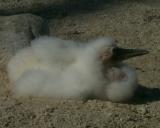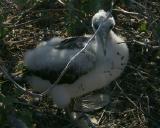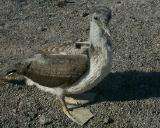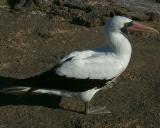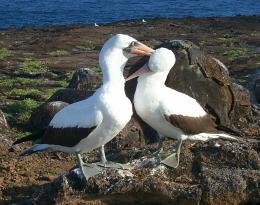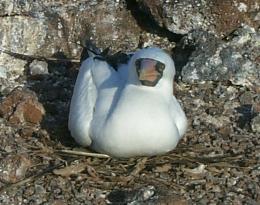May 31 Genovesa
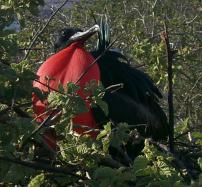
|
| Male frigate bird
|
In the morning the ship made its way inside the large circular Darwin Bay of Genovesa. This is a collapsed caldera and is 300 feet deep in the middle. Though the cliffs around the edge are low (60 feet) they extend deep under the water.
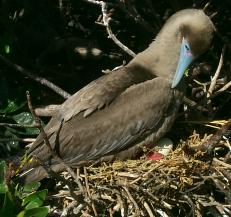
|
| Red-footed booby with egg
|
Genovesa is the home of nesting red footed boobies and frigate birds. The red footed boobies are typically all brown and their feet are dull red. Many of the male frigate birds still had their bright red gullets puffed up to attract mates. Many others were already on their nests. The boobies nested in the red mangroves just beyond the beach. Most were sitting on nests with an egg. One nest had a very scrawny baby apparently just recently hatched. On the beach was a large fluffy baby. Lucho said once they got that size the parents would leave it on the beach while they went out for food. Amazingly the frigate birds seem to leave the boobies alone.
We sat on the beach and watched as swallow-tailed gulls came to the beach to pick up small black rocks and fly them back to their nests. Most of the beach itself was white, apparently broken up coral. This was surprising given that most of the rock around here is the same dark brown volcanic color we've seen on other islands.
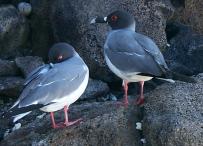
|
| Swallow-tailed gulls
|
After the visit to the beach we took our last snorkeling trip. It was neat to see the underwater cliffs extending down into the green deep. Lots of angel fish, damsel fish, and parrot fish. No sharks or sea turtles today but we did see a sea lion, which may well have been a fur seal though I didn't see it up close.
After lunch we went on a hike along the top of the cliffs. But first we took the zodiac along the cliff face. We saw a lot of tropic birds flying and a couple of them resting in the nooks of the cliffs. Also saw some nazca boobies sitting on ledges and a few fur seals lying around just above the water line.

|
| Gull with rock
|
We docked at Prince Philip's Steps allowing us to walk right up the cliffs. At the top were many baby nazca boobies of various ages waiting for the parents to return. When the parent came the baby would stick its beak down the throat of the parent and the parents would help by regurgitating. Yum!
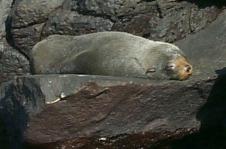
|
| Fur seal
|
Also we saw more nesting frigate birds. A little further on were some low trees where red-footed boobies were nesting. We didn't see any babies but saw several sitting on the nests they build in the trees. Further towards the outer edge of the island we saw many more nazca boobies and juveniles. Matthew, Audubon's naturalist on board, said that nest-building is an instinct in birds and is hard-wired into their DNA. In some birds nest-building can become quite elaborate, but in some of the Galapagos birds, with a lack of predators, it has become a subdued relic of their ancestry. This is evident especially in the nazca and blue-footed boobies whose nests consist of a few twigs and rocks placed in a rough circle on the ground. But when one of the pair brings a twig or rock the other one shows appreciation by rubbing its neck with its beak.
At the edge of the island many frigate birds flew around along with petrels and returning boobies. We were looking for owls but didn't see any. Genovesa doesn't have any lava lizards which seems strange after having them constantly under foot at all the other islands.
That was our last excursion. Everybody wishes we had another one tomorrow.
Lindblad's Daily Expedition Report



